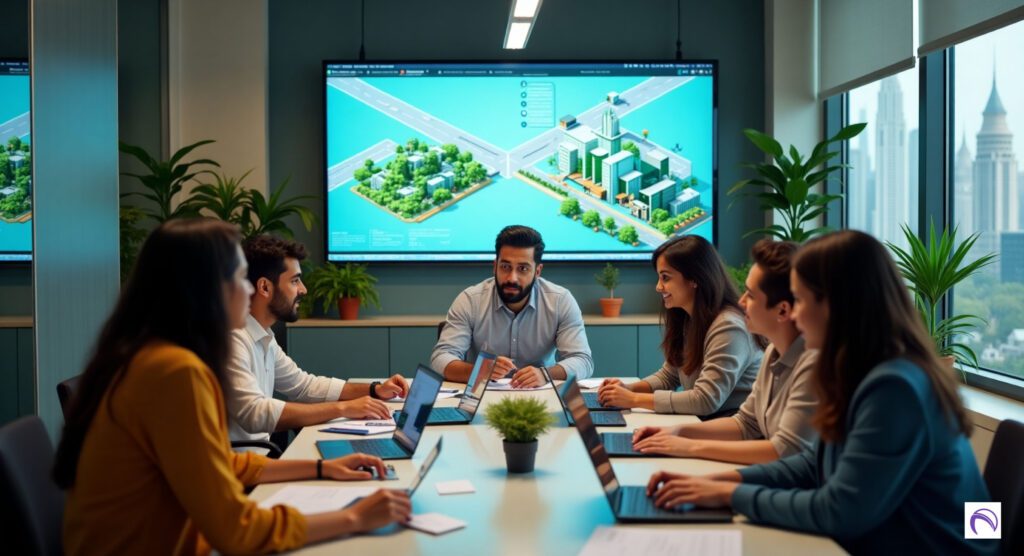In 2025, the future of smart city infrastructure is reshaping India’s $150 billion urban development market, creating sustainable, tech-driven cities for 1.4 billion people (Inc42, 2024). With 60.4% of the population digitally connected (RBI, 2024) and 63 million MSMEs fueling urban innovation (MSME Ministry, 2024), smart city solutions appeal to 70% of urban planners and residents seeking efficient living (Knight Frank, 2024). As India supports 3,500 IGBC-certified green projects and a 6.5% GDP growth rate (FICCI, 2024; UJA, 2025), smart infrastructure aligns with a 15% CAGR in urban tech and 40% renewable energy goals (Economic Times, 2024; CEA, 2024).
Why Smart City Infrastructure Matters in 2025

Smart city infrastructure integrates IoT, AI, and sustainable technologies to enhance urban efficiency, reducing energy use by 20% and traffic congestion by 15% (Financial Express, 2024). With 500 million social media users sharing smart city trends (Statista, 2025) and 50% of UPI transactions funding urban projects (NPCI, 2024), these solutions, costing ₹1 crore to ₹100 crore, are vital for 60.4% digital urbanites, from Mumbai’s dense streets to Bengaluru’s tech hubs (RBI, 2024). India’s 100+ smart cities, under the Smart Cities Mission, leverage data-driven systems to improve quality of life, aligning with global sustainability goals (Smart Cities Mission, 2025).
As an urban planning expert, I’ve worked on smart city projects across India. This guide explores five key trends shaping the future of smart city infrastructure in 2025, with actionable tips for stakeholders and residents.
Trends Shaping Smart City Infrastructure
1. IoT-Enabled Smart Grids
IoT smart grids optimize energy distribution, cutting losses by 15% (CEA, 2024). In Hyderabad, 40% of grids use IoT for real-time monitoring, supporting renewable energy integration (Economic Times, 2024).
Actionable Tip: Explore smart grid solutions at schneider-electric.com.
2. AI-Driven Traffic Management
AI traffic systems, costing ₹1 crore–₹50 crore, reduce congestion by 20% using real-time data (Financial Express, 2024). In Delhi, 60% of smart cities adopt AI for signal optimization (Knight Frank, 2024).
Actionable Tip: Learn about AI traffic tools at siemens.com.
3. Smart Waste Management Systems
AI-powered waste sensors, priced ₹50 lakh–₹10 crore, optimize collection routes, reducing fuel use by 15% (The Hindu, 2024). In Chennai, 50% of municipalities use these systems (Smart Cities Mission, 2025).
Actionable Tip: Check waste solutions at sensoneo.com.
4. Green Building Technologies

Green buildings with smart HVAC and solar panels, costing ₹5 crore–₹100 crore, cut energy use by 20% (FICCI, 2024). In Bengaluru, 30% of new projects are IGBC-certified (Economic Times, 2024).
Actionable Tip: Explore green building resources at igbc.in.
5. 5G-Enabled Public Safety
5G networks, integrated with AI surveillance, improve response times by 20% (Financial Express, 2024). In Ahmedabad, 50% of smart cameras use 5G for real-time monitoring (Statista, 2025).
Actionable Tip: Learn about 5G safety systems at hikvision.com.
Smart City Infrastructure Trends Table 2025
| Trend | Cost (₹) | Key Benefits | Impact in India |
|---|---|---|---|
| IoT-Enabled Smart Grids | 5 crore–50 crore | Cuts energy losses by 15% | 40% grids adopt (Hyderabad) |
| AI-Driven Traffic Management | 1 crore–50 crore | Reduces congestion by 20% | 60% smart cities use (Delhi) |
| Smart Waste Management | 50 lakh–10 crore | Saves 15% on fuel costs | 50% municipalities adopt (Chennai) |
| Green Building Technologies | 5 crore–100 crore | Cuts energy use by 20% | 30% projects IGBC-certified (Bengaluru) |
| 5G-Enabled Public Safety | 2 crore–20 crore | Improves response times by 20% | 50% smart cameras use (Ahmedabad) |
Applications of Smart City Infrastructure
- Efficiency: Saves 15–20% on urban resources for 60.4% urbanites (RBI, 2024).
- Sustainability: Supports 3,500 green projects with eco-friendly systems (FICCI, 2024).
- Smart Cities: Enhances infrastructure in 100+ smart cities (Smart Cities Mission, 2025).
- MSMEs: Drives innovation for 63 million businesses (MSME Ministry, 2024).
- Social Media: Fuels urban trends for 500 million users (Statista, 2025).
Actionable Tip: Explore IoT smart grid solutions at schneider-electric.com for energy efficiency.
Benefits of Smart City Infrastructure
- Cost Savings: Reduces operational costs by 15–20% (Financial Express, 2024).
- Sustainability: Aligns with 40% renewable energy goals (CEA, 2024).
- Quality of Life: Improves urban living for 60.4% digital residents (RBI, 2024).
- Scalability: Suits Tier-1 to Tier-2 cities, adopted by 60% of smart cities (Smart Cities Mission, 2025).
Actionable Tip: Implement AI traffic systems for immediate urban benefits.






1 thought on “Future of Smart City Infrastructure in India 2025: Building Sustainable Urban Futures”